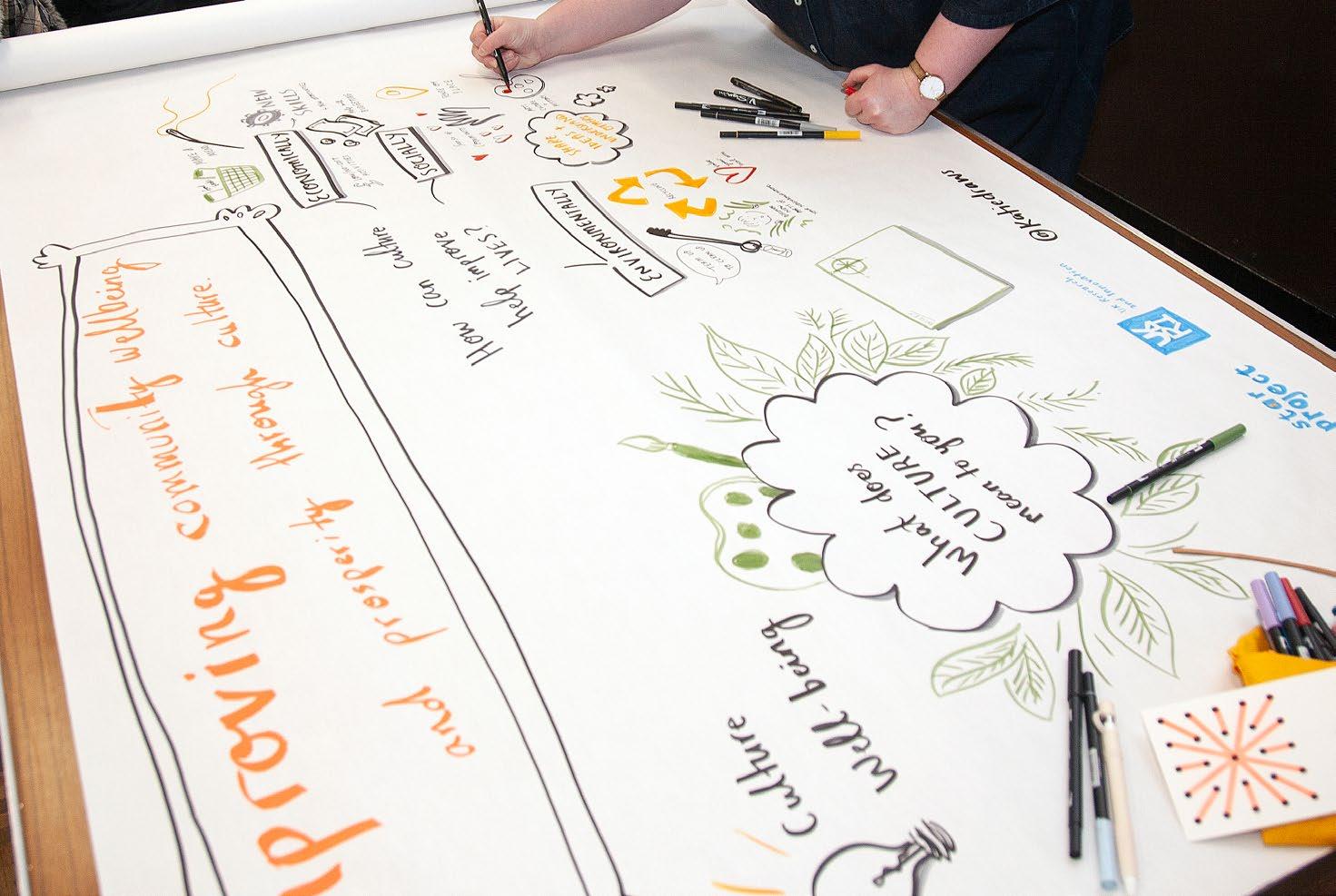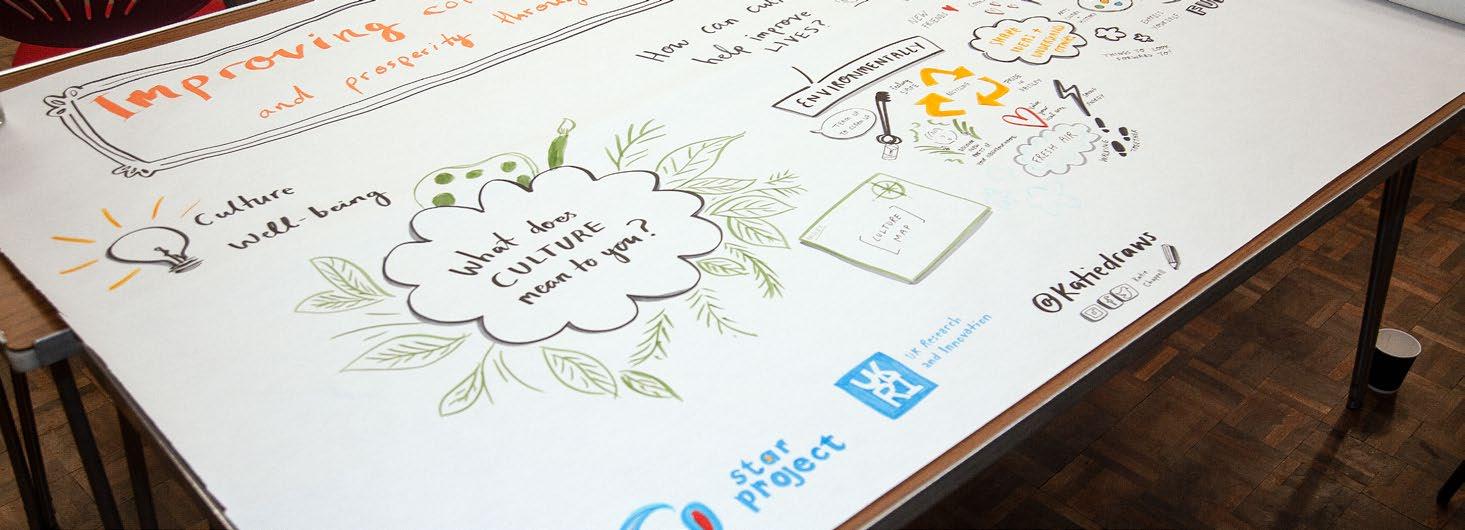
6 minute read
4.0 Art, culture & the alleviation of poverty; development and transition economies
from The Role of Arts & Culture in Lifting Communities Out of Poverty, A Review of Evidence
by ccse_uws
Ruiz’s comprehensive review of literature examining ‘the social and economic impacts of culture, the arts and sport’ (2004:7) assessed evidence in order to provide a robust basis for policy decision making in Scotland. The review acknowledged the Scottish Government’s recognition of the potential value of arts and culture for processes of social inclusion, regeneration and promoting ‘a sense of place and pride in the community’ (Ruiz, 2004:7-8). However, it is also recognised that the benefits of such interventions are difficult to identify (Ruiz, 2004:7-13) and, the evidence to demonstrate the ‘impact of participation in arts or cultural activity on the creation of jobs or finding employment’ in particular, is scarce (Ruiz, 2004:81).
More recently, it is interesting to note the observation made by Grauer et al (2001:46-5) that ‘the shift from traditional manual and industrial work to jobs based on information, communication and the provision of services has placed a renewed value on the kinds of skills which are learned through arts and cultural education – creativity, flexibility, empathy, adaptability, communication and social skills’ (also see: Cultural Learning Alliance, 2019). This shift might provide a potential pathway away from material poverty based in arts, culture and craft – this could be advantageous as evidence suggests ‘that 87% of job roles in the creative economy are at no or low risk of automation’ compared to 4 in 10 jobs in other sectors (Cultural Learning Alliance, 2019). Arguably, however, it is challenging to realise this potential within the rubric of arts projects and interventions as currently conceived. It is worth acknowledging the findings of studies analysing the economic impact of flagship arts projects such as Turner Contemporary in Margate and Hepworth Museum in Wakefield. While the regional level return on investment is straightforwardly recognised,9 it is important to acknowledge that the employment opportunities generated in such circumstances are typically ‘mostly part-time, insecure or low wage, and therefore, are far from being a solution for contemporary problems of structural unemployment’ (Belfiore, 2002:95. Also: Long et al, 2002:38&85; Jermyn, 2001: Matarasso, 1997:7.2; Foley et al, 2007:51; Bakare, 2020).
Advertisement
Campbell et al highlight the emphasis on economic indicators as a measure of success noting that, the ‘economic case for leveraging cultural and creative industries can be overstated’ which can, in turn, obscure other benefits (Campbell et al, 2015:41-2) although economic impacts are perhaps more straightforwardly measured that their psychosocial counterparts (Campbell et al, 2015:50). This pinch point also emerges in the CWLC report on Welsh government efforts to tackle poverty and social exclusion by leveraging culture. Although poverty reduction is one of the overarching aims of the programme’s flagship vehicle – the Fusion Programme – and the work undertaken within Fusion is evaluated according to indicators that foreground employability skills,10 the report narrative elides both economic and psychosocial causes/effects of poverty.
Butler and Leathem (2014) state the case for using social return on investment (SROI)11 measures to discover and understand the change achieved – as opposed to outcome attained – through a project or intervention. SROI measures enable capture of value that may elude conventional financial accounting. SROI involves stakeholders in the process, providing space for them to articulate ‘how value is created for them.’ Relating the methodological steps necessary to attain SROI values, Butler and Leathem note that ‘following SROI convention, and apply[ing] appropriate financial proxies to place values on [outcomes enables] the monetisation of outcomes.’ This is a distinctive element of SROI, leading to the ‘expression of a return value resulting from the investment in a given activity’ (Butler & Leathem, 2014: 4-6).
9 Locating the Turner Contemporary in Margate created 49 FTE jobs and supported a further 81 FTE roles. In its first year of operation, Hepworth Wakefield attracted 500,000 visitors contributing approximately £10,000,000 to the local economy (ACE, 2014:19-20). 10 See section 4.1.3 for listing, also see: CWLC, (2019:35). 11 Defined ‘ a social accounting framework […] [providing] a set of tools for undertaking an analysis of social value that is created (or destroyed) for key stakeholders in particular activities’ (Butler & Leathem, 2014:10).
The literature examining the role and effect of arts and culture in developing and transition economies provides the most clearly identifiable examples of a causal link between this activity and a positive change in material circumstances. South African governmental researchers observed that ‘research since the early 1990s clearly indicates that arts and culture are integral to sustainable development in many developing countries [and that] [t]his trend is in line with the use of arts and culture in urban regeneration’ (Hagg: 2006, 4).
Sagina (2005) provides numerous examples of small, medium and larger scale enterprise endeavours seeking to exploit local creative industries and their outputs for economic advantage, arguing that, if fostered and exploited effectively, ‘creativity can provide new opportunities for job creation, income generation and poverty alleviation in developing countries’ (Sagina, 2005: 25). Exploring the example of the African music industry, the author notes the inherent contradiction currently at the heart of that continent’s music industry; namely that global popularity and success do not translate into jobs in Africa as the majority of African music that reaches an international audience is produced in Europe (Sagina, 2005: 17). Despite this paradox, the author highlights that the continent-wide embeddedness of creativity creates a ‘ubiquitous asset’ (Sagina, 2005: 25; also see Grauer et al, 2001) functioning as an attainable alternative to agriculture as a locus for income generation where appropriate access to international markets can be negotiated (Hagg, 2006: 19; also see Sagina, 2005: 1 & 34).12
The economic arguments for the expansion13 and exploitation of arts and culture in development contexts outlined above are also reflected in Sim’s (2017) discussion of the role of art and culture in community development in Indonesia. This study examines the case of the Creative Communities programme ‘designed to empower people to participate in the community planning process of the large-scale National Program for Community Empowerment (PNPM)’ (Sim, 2017:171) which comprised the Indonesian Government’s foremost poverty reduction plan (Sim, 2017:171). Sim’s analysis broadens the frameworks set out above, acknowledging that arts and culture can produce a range of benefits. On one hand, there are the ‘well-recognised economic benefits of culture tourism and creative industries; at the other end [of the spectrum], the benefits of arts and culture in fostering participation and social inclusion in community participation are equally valuable but less tangible’ (Sim, 2017:171). In this study, Sim notes the use of forms such as puppet theatre, folk song and dance, poetry as pathways for the effective communication of thoughts and values (Sim, 2017:176) and finds that the case study project ‘has clearly demonstrated the ability of community arts to motivate community participation in village development planning’ (Sim, 2017: 179).14
Dirksen’s research on the applications of cultural wealth for surviving material poverty analyses a Haitian case study (Dirksen, 2013). The author seeks to address the question of whether culture ‘can be exploited to enhance daily life and improve material existence’ (Dirksen, 2013:43). The research reveals the activities of grassroots groups using music ‘as an explicit and fundamental tool for addressing complex and distinctly non-musical social issues’ deriving from material poverty and associated infrastructural flaws (Dirksen, 2013:43). One such example comprises the rap collective Wucamp who rallied their community to tackle the issue of mountains of uncollected garbage that despoiled their Port-au-Prince locality causing significant concern along with psychological and physical stress (Dirksen, 2013, 49-52). In fact, the teenaged rappers made significant investments of time and effort for no financial return for themselves, their families or wider communities. Instead, gains were achieved in terms aligned with ‘education and infrastructure […] [and] boosting the community’s dignity and self-sufficiency […] [encouraging] agency among people who could readily become victims’ (Dirksen, 2013:52 & 54). Activities are analysed using cultural action as a frame of
12 Also see Gould (2001:72) re: the importance of accounting for cultural context in design of a cultural/arts project intervention. 13 Echoing Sagina’s observation of the centrality of the practise of cultural/arts forms for day-to-day identity. 14 See Foley et al (2007), Flinn & McPherson, (2007) for discussion of research based in the Scottish context and examining the intersection of culture, community, participation and Community Planning Partnerships in North Glasgow.








